Takeda
The exploits of 16th-century Japanese daimyo Takeda Shingen have served as the inspiration for books, plays, movies, and now--perhaps most fittingly--a real-time wargame from indie developer Magitech.
Takeda
Developer: Magitech Corporation
Publisher: TBA
Release date: March 2001
By T. Byrl Baker
The exploits of 16th-century Japanese daimyo Takeda Shingen have served as the inspiration for books, plays, movies, and now--perhaps most fittingly--a real-time wargame. Jaleco released a horrible console game called Takeda Shingen in 1988, but Magitech Corporation's upcoming Takeda should be the definitive take on both the life of "The Tiger of Kai" and the conflicts that took place during his reign.
Great pains have been taken to accurately model the combat of the period. Armies are composed of five different unit types, with spearmen, basic infantry, and cavalry available for melee attacks and archers and riflemen for ranged attacks. These units are used to form battalions, which take orders from captains. Battalions can be grouped to form divisions, which are commanded by generals, and several divisions create an army under the command of a marshal.
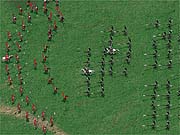
The chain of command will be important to learn, as you basically assume the role of the marshal and exercise indirect control over the other combat units. You may tell a captain to have his battalion attack an enemy stronghold, but if the captain is cowardly, he won't carry out the order. Alternatively, if the captain is bold and foolish, he may carry out that order yet refuse to listen to the marshal's command to break off the attack.
Officers who manage to survive battles in the campaign mode gain experience and will become more efficient and predictable as the game progresses. Officers are represented on the map along with the other troops, and if they are killed, the consequences are dire. Heroes and other characters who existed during Takeda's lifetime will also be included in the game, and they'll modeled by giving them stats that reflect their historical talents and abilities.
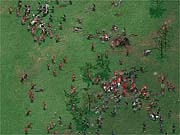
The real-life Takeda was famous for his creative tactics, and you should be able to re-create the battles of the period in terrific detail. Dozens of historical formations add to the game's tactical possibilities, and players have direct control over the formations of armies and divisions. The AI controls battalion formations based on the personality of the captain in command and the orders currently being carried out. Detachments can be sent off to harass the enemy's flanks, guard against or carry out ambushes, or attack an enemy's headquarters unit from the rear while the larger battle rages.
Takeda also was well known for making and breaking alliances with other warlords, and you will be able to make the same sorts of decisions in the game's campaign mode. With a strong enough economy, shrewd political dealings, and a sound battle strategy, it will be possible for you to conquer all of Japan during the campaign--something even Takeda himself couldn't manage. Aside from the campaign, players can partake in single historical battles or go head-to-head in a multiplayer mode that is currently being designed to work over direct modem connections, the Internet, or a LAN.
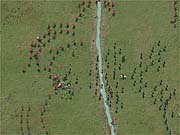
The developers' research has extended to castles and other fortifications of the period, which will all be represented in the game. Most of the structures are based on original blueprints and should add extra tactical depth, since sieges should be just as arduous and dangerous in the game as they were in Takeda's day. We spoke with Ming-Sheng Lee, Takeda's project director, to see how the game is shaping up and get his take on what it's like to be part of an independent development team.
Next: Q&A with Takeda's project director Ming-Sheng Lee
Q&A With Takeda Project Director Ming-Sheng Lee
GameSpot: When can we expect to see the final version of the game?
Ming-Sheng Lee: We'll have the game ready for demo by the end of March. However, the final version might still take a month or two to polish up after that.
GS: Has anyone inspired you to do what you've done?
MSL: Not really, except that I have liked to play toy soldiers since I was a kid. My father told me a lot of stories about Japan's history and seeded the idea behind the Takeda.
GS: Are there any games that influenced Takeda?
MSL: Yes and no. Before Takeda was officially started, we were working on a game code-named K1. We were using hand drawings to create the animated units. Microsoft's Age of Empires made us stop the K1 project because we simply couldn't compete with it using hand-drawn animation. Takeda is the next generation of K1. With Takeda, we used motion-capture and 3D-rendered objects (in Maya) to replace the hand-drawn animation.

GS: What sets Takeda apart from similar games?
MSL: We have compared Takeda with many other similar titles, but it is still unique in many respects. Not many other games emphasize formations or have implemented the AI the way we have. In Takeda, units aren't just put in position and called a formation. Divisions in formation really work as a formation. If the player chooses the wrong formation for the job, he or she can get into real trouble on the battlefield. As for the AI part, we try to make the units behave more like real soldiers--you can see them walk, approach, charge, fight, get tired or scared, and run away. When you put both the formation and the AI together, you see a battle instead of a mess of fighting units.
GS: Can you tell us more about how the formations will work?
MSL: There are 16 army formations, 12 division formations, and many other battalion formations. The player gets control of both the army level and the division level of formations. Battalion formations are handled by the AI.
All the formations have different strengths, weaknesses, and tactics that can be employed. For example, in wing formation (an army-level formation), when attacked from the center, you can pull back your center division and wait for the enemy to charge into the space created. The side divisions can then swing in and trap the opponent. When attacked from one flank, you can close the attacked wing and draw the enemy deep inside the rear while opening the other wing to flank the enemy and get them from the rear. We will be posting some visual explanations of formations on our Web site very soon, and then all this will make much more sense.

GS: How much historical research has gone into Takeda?
MSL: Indeed, we have done a lot of historical research about the characters of Takeda and the story itself. In the character personality part, for example, there's a general named Baba who fought in more than 70 battles and never got hurt once. People called him "the ghost of Minano." We have implemented this in the game by giving him a very high survival rate. In the battle of Nagashino, when Baba saw most of his comrades killed by the enemy rifles, he refused to retreat and charged into enemy line by himself while the whole army was retreating. We have implemented this by using certain conditions to trigger the event in Takeda's campaign mode.
Next: Four levels of artificial intelligence?
On the terrain part, most of our castles are based on historical designs. We couldn't make them exactly perfect for various reasons (such as path-finding issues and so on), but they are closer than those of many other games. The same goes for other buildings and the battlefield layouts. We also made sure that the formations, weapons, and troop behavior matched history as much as possible. The loss of a commanding officer had a major impact on the morale of the soldiers back then. Sometimes, losing a single general could make the whole army refuse to fight and retreat.
GS: You say Takeda has four levels of AI. How are they implemented?
MSL: Different from [the AI] in lot of other games, Takeda's AI is modeled on a military chain of command. This way the player can see troops acting like members of an army, instead of just a big mass of units moving together. For example, a unit/soldier sees an enemy but decides not to engage because he has orders from his battalion to advance instead of engage. However, the unit comes under heavy attack and decides to ignore his orders so he can defend himself. The battalion then notices that some men are under attack and orders the rest of the troops to help them out. Meanwhile, the rest of the division (three other battalions) has become tired of waiting for the battalion and orders the others to charge ahead to the main enemy line, leaving the one battalion behind. The army sees the division is charging and gives orders to other divisions to launch a flanking attack. Yes, it's complicated, but it's the way to make it realistic--and the player doesn't really have to worry about most of it.
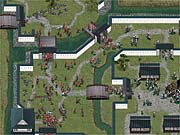
GS: One of the more intriguing aspects of Takeda is the ability to break off a small detachment of troops from the main body. How does this affect gameplay?
MSL: The night before the battle starts, you are thinking about how to beat the enemy on the field tomorrow. There's a route where a part of our force can strike the enemy from the rear, but would they set up an ambush there? If we split the main army, will we have enough troops to stop the main enemy force until our detachment can arrive?
Detachments actually play a major role in the gameplay in many cases. When the player sends out a detachment, he or she doesn't know if the detachment will arrive in time, or if it will even appear at all (since it can be delayed or destroyed by an enemy detachment).

On the field, you have to decide whether or not to leave divisions behind to guard your headquarters from enemy detachments. This might leave the main force a little weaker than it would otherwise be; it could have a major impact on the battle, even if no detachment comes. Of course, if you don't do this, you risk being caught off guard when a couple of enemy cavalry divisions smash your HQ into the dirt.
GS: How is terrain factored into the battles?
MSL: The terrain provides certain effects on the field. For example, soldiers will move slower and suffer from more fatigue when climbing uphill. Archers will shoot at a longer range when shooting at enemies at lower elevations. Forests will naturally hide some of your units and slow down most cavalry charges. Castle walls can block some percentage of long-range weapons from outside but allow the defender to shoot out freely. Mist and fog shorten the units' sighting range; often they engage the enemy a bit too late.
GS: Officers can gain experience in Takeda. How does this affect the gameplay?
MSL: In both campaign mode and dual mode, the fighting experience, which accumulates from battle to battle, will be saved. In combat, experience controls 40 percent of the probability of hitting the enemy. A unit with low experience is more easily intimidated (more likely to run) than a veteran. Experience also varies from unit type to unit type. For example, a fresh spearman has more strength than a fresh swordsman, but a veteran spearman will not be as good as a veteran sword master. Experienced units can also change the gameplay in the sense that you will be inclined to use them more wisely since you have been building them up for a long time.
GS: Are there ways to hide your troops' movement in the game, like placing them behind a line of trees or keeping hills between them and the enemy?
MSL: Since Takeda is focused on a single battlefield, it's not really possible (or fair) to hide large groups of units. For our purposes, we assume that most of the time the enemy scouts would eventually find hidden divisions anyway. OK, admittedly, there are situations like when French cavalry charged into British squares behind the hill at Waterloo. Maybe in the next version of Takeda, we will make the divisions able to hide behind the hills.
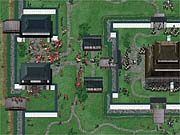
Basically, the AI always knows where your troops are, and you can always locate the enemy. However, in practice, it is possible to protect your men from cavalry charges and from the attention of enemy divisions by using trees. A creative player can still find ways to sneak a division or two around the battlefield and create ambushes whether the opponent is human or AI. The AI sometimes tries to do this sort of thing too (though not as well).
GS: Did you discover any interesting things while researching the castles and forts that are featured in the game?
MSL: Takeda was originally scheduled for release last fall. However, after we decided to add the castle features, we couldn't stop building those beautiful fortresses. We studied why and how they built the castles the way they did, and we tried to implement those features in the game.
GS: How many unit types will appear in the final game, and what role will they play in battles?
MSL: There are five types of soldiers with four types of commanders in the game: Spearman, the backbone of your army, can stop most cavalry charges and keep the formation intact; infantry swordsman, the muscle of your army, can penetrate most spearman lines and break the enemy formation; cavalry, the elite of your army, has great speed and can also trample enemy foot soldiers--cavalry charges invoke great fear in the enemy; then archer and rifleman, the support units of your army, can soften enemy from a distance before they get a chance to get you. This is especially true for the riflemen; they are great for taking out enemy generals and cavalry.
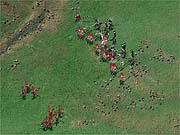
GS: Where is Takeda headed in the future?
MSL: We plan to improve the castle battles as well as the Internet features in the future. If possible, we would like to create a whole new series of battles in different theaters based on the same game [engine].
GS: As an independent developer, what has been the biggest obstacle you've faced in producing your games?
MSL: Time, I would say. As a small developer, we are really under deadline pressures. We have only limited assets to dispatch, and the industry requires so many.
GS: Any tips for other independent teams who want to publish a game on their own?
MSL: Have a financial backup first before you move. A great idea doesn't exist if you can't finish it.
GS: What do you think the future looks like for independent developers? Will it become harder to do what you do?
Next: Technology, tools, and time to play games
MSL: I believe the spirit of a game isn't wrapped up in its visual and audio effects, but is instead in the gameplay itself. If that spirit is still alive, then the independent developers still have room to go.
GS: Were you hindered by technology in any way during the development of the game?
MSL: Graphics are mostly where the tools were needed. We spent a lot of our budget getting the graphics end of the job done. On the programming part, we relied more on our own research than buying libraries. We learned a lot that way and we get the satisfaction of it, but doing it ourselves takes time.
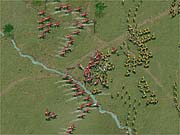
GS: What tools did you use in the creation process?
MSL: We used motion-capture, FilmBox, Maya, and 3D Studio MAX, among other things, to create our animation, terrain objects, and images. The programming was done exclusively in VC++.
GS: How is beta testing going?
MSL: Since we don't yet have a beta version, we haven't done beta tests. However, we have had some people test our in-house version to get some feedback on the game and test the interface. We usually ask them not to look at the manual but to play the game directly. That way, we could see how intuitive our interface is and work out any improvements we needed to make. Testing has been mostly feature-oriented, since a lot of the content (campaign mode) is still in the works.
GS: Do you have time to play other computer games?
MSL: I've played a lot of wargames, as well as a few others over the past 15 years. I still like the old games better because of the gameplay. A few notable games are Second Front and/or War in Russia from SSI, and of course Civilization. Back to the age of the Apple II--those wargames are really much better than today's.
Everybody on the team plays other games when they can. Our artist and writer like RPGs a lot, and pretty much everybody gets in on the office matches that we sometimes have, although most of us are too busy to play a lot of games these days. Quake is definitely the office hit. Civilization, Unreal Tournament, Tomb Raider, Final Fantasy, Warcraft, Age of Empires, SimCity, Grand Theft Auto, Diablo, and Jedi Knight are all favorites of at least a few people on the team.
GS: Are there any other projects in the works that you'd like readers to know about?
MSL: We have another project, Vegas, an online casino game, done years ago as a joint venture with a partner company. We created the client side of the game. It features user-friendly drag-and-drop interfaces and realistic screens and gameplay. You can really see the roulette wheel turn and you really move the card to split the hands in blackjack. We might put it up on our Web site later for people to see.
Got a news tip or want to contact us directly? Email news@gamespot.com
Join the conversation